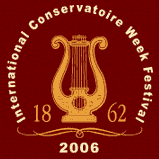
|
|||
 |
|||
 |
|
THE JUILLIARD SCHOOL |
At the time of The Juilliard School’s foundation in 1905 (as the Institute of Musical Art), the idea of establishing a music academy in America which would rival the European conservatories was a novel one. But Dr. Frank Damrosch, the godson of Franz Liszt and the head of music education for New York City’s public schools, was convinced that American musicians should not have to go abroad for their training. But the Institute is only half the story of what is now known as The Juilliard School; Augustus D. Juilliard and the Juilliard Graduate School provide the other half. When Mr. Juilliard, a wealthy textile merchant, died in 1919, his will contained the largest single bequest for the advancement of music at that time. In 1924, the trustees of that bequest founded the Juilliard Graduate School to help worthy music students complete their education. In 1926, the Graduate School and the Institute of Musical Art merged as the Juilliard School of Music under one president, the distinguished Columbia University professor John Erskine, but with separate deans and identities. In 1937, Ernest Hutcheson succeeded Erskine as president of the combined institutions. Composer William Schuman, became president of the combined schools in 1945. Under his administration, the merger process of the schools was completed. Schuman established the Dance Division in 1951. He also established the Juilliard String Quartet in 1946. He resigned in 1961 to become president of the newly constructed Lincoln Center. Dr. Peter Mennin, another well-known composer, was Schuman’s successor. In 1968 Mennin created a Drama Division and oversaw the move of Juilliard to Lincoln Center in 1969. The School changed its name to The Juilliard School to reflect its broader artistic scope. In 1983, Dr. Joseph W. Polisi became the School’s sixth and current president. Dr. Polisi’s term at Juilliard has been a time of vitality for the School, with the establishment of new student services, alumni programs, a revised curriculum, a new emphasis on the humanities and liberal arts, and the realization of two major goals: the completion of its first residence hall — the Meredith Willson Residence Hall — which opened in 1990, and the establishment of a jazz program — the Institute for Jazz Studies (a collaboration of The Julliard School and Jazz at Lincoln Center) — which began in September 2001.
|

